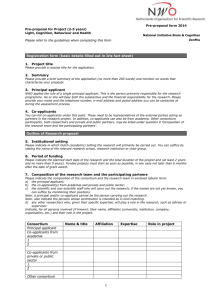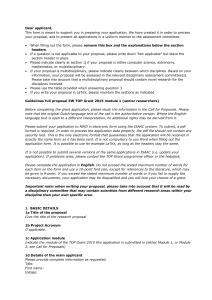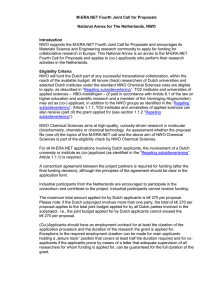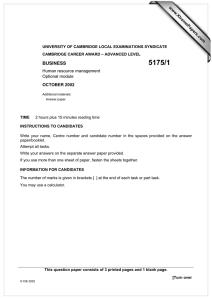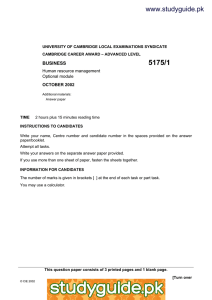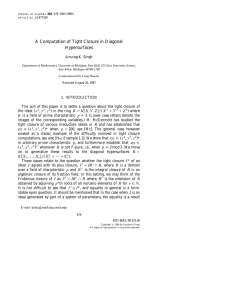TOP Grants
advertisement
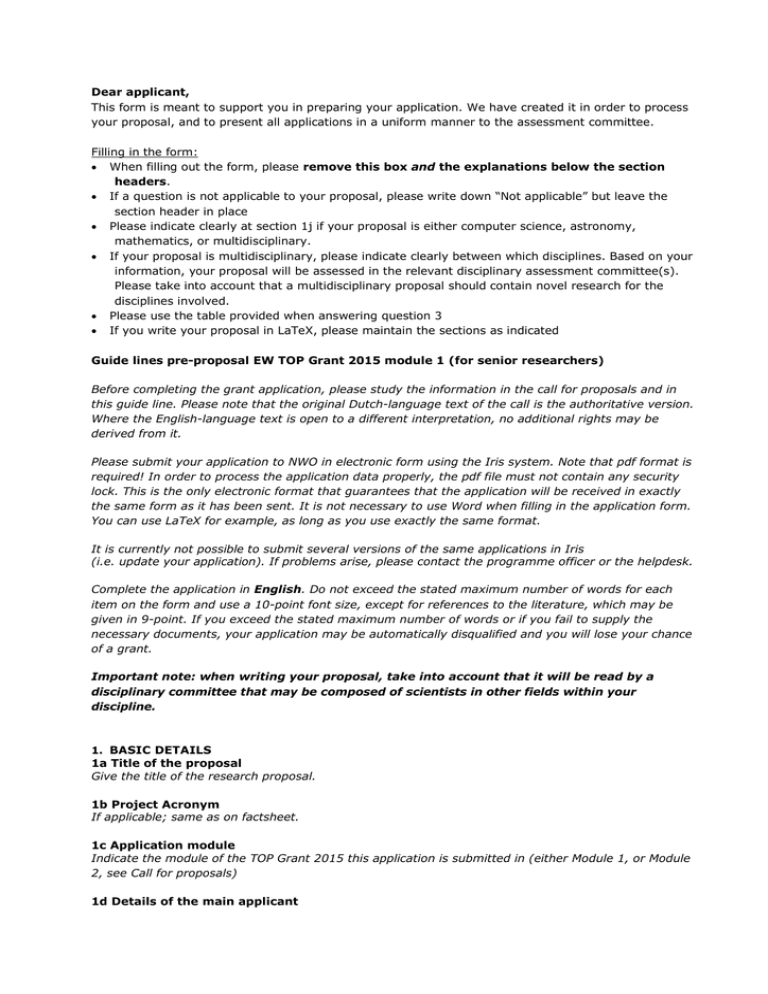
Dear applicant, This form is meant to support you in preparing your application. We have created it in order to process your proposal, and to present all applications in a uniform manner to the assessment committee. Filling in the form: When filling out the form, please remove this box and the explanations below the section headers. If a question is not applicable to your proposal, please write down “Not applicable” but leave the section header in place Please indicate clearly at section 1j if your proposal is either computer science, astronomy, mathematics, or multidisciplinary. If your proposal is multidisciplinary, please indicate clearly between which disciplines. Based on your information, your proposal will be assessed in the relevant disciplinary assessment committee(s). Please take into account that a multidisciplinary proposal should contain novel research for the disciplines involved. Please use the table provided when answering question 3 If you write your proposal in LaTeX, please maintain the sections as indicated Guide lines pre-proposal EW TOP Grant 2015 module 1 (for senior researchers) Before completing the grant application, please study the information in the call for proposals and in this guide line. Please note that the original Dutch-language text of the call is the authoritative version. Where the English-language text is open to a different interpretation, no additional rights may be derived from it. Please submit your application to NWO in electronic form using the Iris system. Note that pdf format is required! In order to process the application data properly, the pdf file must not contain any security lock. This is the only electronic format that guarantees that the application will be received in exactly the same form as it has been sent. It is not necessary to use Word when filling in the application form. You can use LaTeX for example, as long as you use exactly the same format. It is currently not possible to submit several versions of the same applications in Iris (i.e. update your application). If problems arise, please contact the programme officer or the helpdesk. Complete the application in English. Do not exceed the stated maximum number of words for each item on the form and use a 10-point font size, except for references to the literature, which may be given in 9-point. If you exceed the stated maximum number of words or if you fail to supply the necessary documents, your application may be automatically disqualified and you will lose your chance of a grant. Important note: when writing your proposal, take into account that it will be read by a disciplinary committee that may be composed of scientists in other fields within your discipline. 1. BASIC DETAILS 1a Title of the proposal Give the title of the research proposal. 1b Project Acronym If applicable; same as on factsheet. 1c Application module Indicate the module of the TOP Grant 2015 this application is submitted in (either Module 1, or Module 2, see Call for proposals) 1d Details of the main applicant Please provide complete information as requested. Title: First name: Initials: Last name: Prefix: Male/female: Address for correspondence (during the period of the TOP-round): Preference for correspondence in English: yes/no Telephone: Cell phone: Fax: Email: Website (optional): 1e Co-applicant(s) Please provide complete information for the co-applicants as requested. If there is more than one coapplicant, please fill in the below details for all of the co-applicants Title: First name: Initials: Last name: Prefix: Male/female: Address for correspondence (during the period of the TOP-round): Preference for correspondence in English: yes/no Telephone: Cell phone: Fax: Email: Website (optional): 1f Scientific Summary Provide a summary of your proposal (topic, goal, approach and potential impact of results) in no more than 250 words. This summary, written in more general terms, can also be used to fill out the summary field in the Iris application process. Please keep in mind that this summary will be used to invite possible reviewers, and should as such be a good description of the proposed research. 1g Keywords Specify up to six keywords. NB These keywords will be used to find appropriate referees. Therefore, choose the keywords with care. They should not be too general (e.g. ‘computer science’) nor too specific. 1h Group members involved in the proposed research List all staff members involved in the proposed research; provide name, initials, first name, title(s) and type of involvement, e.g. daily guidance, advisor or thesis supervisor PhD-student. Title: First name: Initials: Last name: Prefix: Male/female: Type of involvement: 1i Abstract for layman (in Dutch) You are also requested to include a summary (maximum 500 words) in Dutch, written for the benefit of researchers in other disciplines and a lay readership. This summary should not be a direct translation of the English scientific summary. It should include: - a clear explanation, in simple language, of the nature and content of your proposal; - an account of past work in this area; - an account of what you intend to do, and why this is important; - an account of the expected results; - an account of why your research may be deemed innovative. If a grant is awarded, NWO may use this summary for publicity purposes. 1j Main field of research (compulsory) For all applications it is compulsory to fill out one or more research fields that correspond to the subject of your research proposal. You can only refer to the descriptions and codes from the NWO research field list. Please find the list via: www.nwo.nl/researchfields code + field of research: ……… If applicable: other fields of research, in order of relevance. Please select other relevant fields of research at: www.nwo.nl/researchfields code + field of research: ……… 1k Relevance to the ‘Top sectors’ The Dutch government has designated nine ‘top sectors’: areas of economic activity to which extra attention is to be devoted. They are: Agrifood, Chemistry, Creative Industry, Energy, High-tech Systems and Materials, Life Sciences, Logistics, Horticulture and Water. For further information, see www.topsectoren.nl. State (where applicable) if and how your project proposal is relevant to one or more of the designated top sectors or to the ICT roadmap, which transcends top sector boundaries. You should also include details of any proposed collaboration with the private sector. This section will not affect the assessment but gives the GB-EW (GB-EW is the abbreviation in Dutch of the the Board of NWO Physical Sciences) a better understanding of the manner in which proposals are relevant to the top sectors and the national economy. 2. RESEARCH PROPOSAL Attention: For section 2a and 2b combined, there is a maximum of 1200 words, not including literature references) 2a Description of the proposed research Describe the proposed research as accurately as you can within the stated maximum number of words. Include details of: Research topic - Overall aim, key objectives, scientific background - Originality and/or innovative elements of the topic - Significance (potential contribution to science, technology and/or society) - The relationship between the proposed research project and any similar or complementary research which is being conducted elsewhere. Approach - Experimental techniques and/or methodology - Risk analysis of the research Innovation - Originality and/or innovative elements of the approach Plan of work - Research plan (practical timetable over the grant period) - Local, national and international collaboration 2b National and International cooperation Describe briefly the ongoing national and international cooperation’s of the main applicant and coapplicant(s) that are relevant to the proposed research. 2c Literature List all relevant literature here and include full bibliographical details. 3. ADMINISTRATIVE DETAILS 3a Budget You may apply for a grant for a minimum of two and a maximum of three research positions (PhD students or post-docs), plus a maximum of € 25,000 for additional resources for the proposed research. The grant may be used for: PhD students and/or two- or three-year post-docs, employed on a full-time basis. An individual bench fee (€ 5000) will be awarded to each PhD student or post-doc to cover (either fully or partially) expenses associated with travel, printing the thesis, etc.; equipment/software required for the project, provided the cost exceeds € 5000. The equipment must be explicitly intended for the project described in the proposal. Sound arguments be presented to demonstrate the need for the equipment. Less expensive equipment/software will be regarded as module of the infrastructure of the research institution, and will not be reimbursed; travel expenses for the research positions in the application, in so far as they are not covered by the bench fee. Sound arguments must be presented to demonstrate the need for travel in connection with the project, particularly for the research positions in the application; other activities associated with the project, such as travel and accommodation expenses for guest researchers and the costs of symposia etc., around the time of graduation, for example. Sound arguments must also be presented in support of these activities. Summary of subsidy application Copy the relevant parts of the table below and complete the required information. (See notes below.) Personnel a. b. c. d. appointment of research personnel State only the research positions; NWO will enter the appropriate amount. PhD 4 years PostDoc 3 years PostDoc 2 years additional travel budget project-related equipment other project-related activities Total b, c, d Number Number Number €……… €……… €……… €……… Motivation of the requested budget: Notes: a) State only the positions for which funding is required: PhD students or postdoc researchers (for a period of 2 or 3 years). The relevant amount, including the individual bench fee, will be entered by NWO in accordance with the standard amounts given in the NWO-VSNU contractual agreements (which can be found here). b), c) and d): Include a budget and justify the amount concerned. The total of the additional budget (items b, c and d) may not exceed €25K. 3b Grant applications If you have submitted a research proposal elsewhere (including other NWO councils) on the same topic as this application, provide relevant information on that proposal. Also include proposals on the same topic submitted by other members of your group or your co-applicants group(s). Include the mentioned information for all grants. title proposal: applicant(s): funding agency: budget applied for: date of submission: date of decision: 4. CURRICULUM VITAE (maximum 2000 words per (co-)applicant) Use the following structure to write your CV. Personal details Title(s), initial(s), first name, surname: Male/female: Date and place of birth: Nationality: Current employment Indicate what kind of contract you have. If you are not an Assistant Professor, Associate Professor or Full Professor, please indicate under ‘Other’ the position you hold and whether it is outside or within the academic sector. Work experience since completing your PhD (only for the main applicant) Give the dates of each appointment and indicate whether it was full-time or part- time (in fte), and whether it was tenured (‘vast’) or fixed-term (‘tijdelijk’). Where an appointment involved (or involves) the management of other researchers, state the numbers of academic and/or support staff supervised. Person-years of research (only for the main applicant) Give the total number of years (fte) that you have spent on research since you obtained your doctorate. If there are any gaps or part-time work in your CV, due to time spent on care or sick leave, or time spent on activities other than research, you may explain them here. It is important that the committee and referees have this information while assessing your track record. NWO understands person-years of research to be the time you have been employed to do research since your doctorate. The person-years of research do not include the time you were appointed to perform management tasks or to teach. As an example, we have calculated the person-years or research for the following CV. Please write your own calculation on your application and use this format. CV June 1999: Doctorate I. July 1999 – December 1999: unemployed. II. January 2000 – June 2003: 0,8 fte position. 80% to be spent on research, 20% on education. III. July – December 2003: sick leave. IV. January 2004 – April 2004: maternity leave. V. May 2004 – December 2008: 1 fte position. 60% to be spent on research, 20% on education, 20% on management. VI. January 2009 – May 2010: 0,8 fte position. 60% to be spent on research, 20% on education, 20% on management. Calculation person-years of research (in months) I. 0 months II. 42 months * 0,8 fte position * 0,8 spent on research = 26,88 months III. 0 months IV. 0 months V. 56 months * 1 fte position * 0,6 spent on research = 33,6 months VI. 17 months * 0,8 fte position * 0,6 spent on research = 8,16 months The person-years of research serve to give reviewers and committee members an indication of the time. you have actually spent on your research. Brief summary of research(maximum 250 words) Outline the content of your research. International activities List activities such as long or short study visits abroad, international collaborations, etc. Other academic activities Include, for example, membership of editorial boards, posts on committees and involvement in the organisation of conferences. Scholarships, grants and prizes List any research scholarships/grants for which you have successfully applied or prizes you have won during your scientific career, with special attention to the last 10 years, and indicate the amount of money involved. Also, indicate clearly what your role in the grant or scholarship was (PI, co-PI, Applicant, etc.). Other relevant information Please other relevant information here, for instance your personal impact-index. Five top publications and five most recent relevant publications Please list your top five publications, and your five most recent publications relevant for the proposed research. In each case, list: the author(s), date, title of the publication, journal or series in which the publication appeared, volume, page numbers, and (if applicable) publisher and place. It is not allowed to include publications which are not already accepted. By submitting this document I declare that I satisfy the nationally and internationally accepted standards for scientific conduct as stated in the Netherlands Code of Conduct for Scientific Practice 2012 (Association of Universities in the Netherlands). There is a possibility to send a list of suggested referees (maximum of six names) and non-referees (maximum of three names). This isoptional for every applicant. The individuals will NOT be asked to assess your application as referees. Please send the list with your application in a separate PDF- file. Please submit the application to NWO in electronic form (pdf format is required!) using the Iris system, which can be accessed via the NWO website (www.iris.nwo.nl). The application must be submitted from the account of the main applicant. For any technical questions regarding submission, please contact the IRIS helpdesk (iris@nwo.nl).
